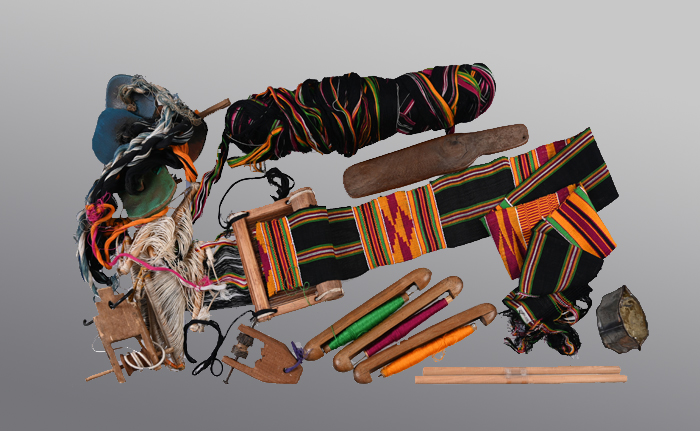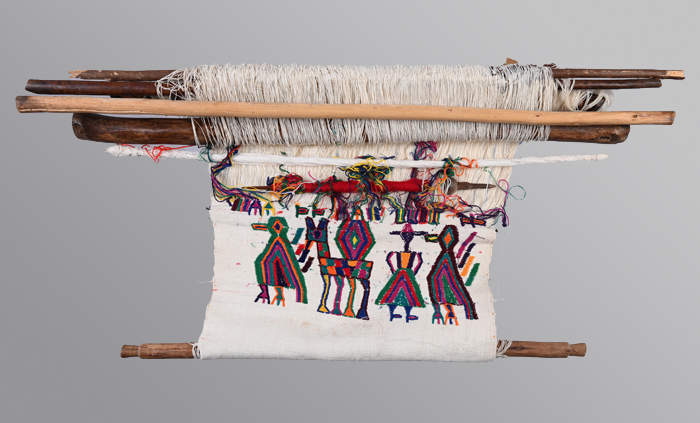April 12, 2023 - March 1, 2024
Curators
Anne Bissonnette, PhD, Siming Guo, PhD, Elsie Osei, MFA, and Chiara Power, BA

The Gendered Production of Cloth
Ghanaian and Maya textiles are a testament to the artistry and craftsmanship of the weavers who create them. Men weave in Ghana and typically do so using traditional narrow strip looms (visual above), whereas Guatemalan women weave and often do so with backstrap looms (visual below). All woven cloth makes use of lengthwise warp threads and intersecting weft threads. Textiles range from plain woven to intricate patterns that can be created via complex techniques and embellished in elaborate ways.
Demonstrations of skills abound. In Ghana, some fabrics may involve changing the color of the yarns, creating complex geometric shapes, and incorporating symbols and other decorative elements in the weave structure.[1] Large fabrics can also be made of an assembly of woven strips . Maya textiles use a sophisticated technique called jaspe—the term for ikat, a better-known Indonesian word—to create intricate patterns and designs.[2] To produce a double jaspe (12), both warp and weft threads are individually covered or tied with materials such as wax or thread before the weaving starts. The covered or tied areas resist dye penetration, creating jagged-edge patterns when the fabric is woven. Similar to Ghanaians, Mayan weavers also create and construct textile designs to connect them to their ancestors through woven objects.[3]
Indigenous textiles utilize longstanding as well as newer techniques and materials, some introduced by colonialism, to produce a unique native textile aesthetic. Weaving remains a fundamental part of being Maya and allows many women to be economically independent. Even women who do not have the time to weave often learn to weave and ensure their children do so as well.[4] The artistry and craftsmanship of Ghanaian and Maya textiles are a real representation of their creativity and ingenuity, as well as a reminder of the need to maintain cultural traditions for future generations.
Anne Bissonnette, PhD
Siming Guo, PhD
Elsie Osei, MFA
Chiara Power, BA

[1] Kingsley Ayiku, “Symbolic meanings in the Ghanaian arts,” 167-168.
[2] Josephine Maria Moreno, “Retailers as interpreters of textile traditions in Antigua, Guatemala” (PhD diss., Iowa State University, 1995), 196.
[3] Callie Vandewiele, “What Our Mothers Wove, We Wear: Heritage Revival in Museum Collections of Guatemalan Textiles,” Journal of Museum Ethnography 31 (2018): 61.
[4] Walter E. Little, “Weaving ritual and the production of commemorative cloth in Highland Guatemala,” Dimensions of Ritual Economy 27 (2008): 140.
